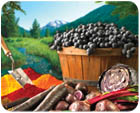
“As [a major] supplier of synthetic colors, it often catches people by surprise that we offer natural colors,” he says. “We have a complete product line of both, and bring our full technical application capabilities when using natural colors. We focus on the needs of customers, and are not biased towards synthetics or naturals.”
For example, Sensient recently introduced a vegetable juice color extract made from black carrot extract. It is targeted to replace grape skin extract and grape juice concentrate. “Compared to those two products, the black carrot extract has improved light and heat stability. It is kosher and you can't get kosher, grape skin extract,” explains Stonecipher.
Over time, the color of grape extracts and concentrates fade when contained in a clear glass bottle, and the color loss accelerates when exposed to elevated temperatures. Black carrot has the advantage of avoiding those problems. Also, it is comparable in solubility and provides the same magenta or reddish-blue color associated with colors from grape products.
Stonecipher also informs that natural colors have beneficial aspects other than those measured by label declarations. Most importantly, they provide manufacturers the opportunity to achieve shades of color that cannot be obtained with synthetics alone in the U.S. “There are some gaps in the color spectrum that can be achieved, and sometimes it requires a blend of synthetic and natural colors together,” advises Stonecipher.
“Surprisingly, some natural colors have better stability.” For example, Red 40, Yellow 5 or Yellow 6 will tend to degrade in a beverage with ascorbic acid, but similar shades can be obtained using beta carotene, carmine or cochineal extract, which are more acid-stable.
Finally, the FDA considers even a natural color artificial if it is not natural to that product. However, a growing number of natural colors are recognized as healthy above and beyond their “natural” associations. For example, products like anthocyanin, beta carotene and turmeric have been reported to possess antioxidant properties. So, naturally, as the strength behind buzzwords like organic and natural grow, so also will the demand for natural colors.
For more information, contact:
Sensient Colors Inc., Milwaukee
Color Service Lab • 800-325-8110
scinfo@sensient-tech.com
www.sensient-tech.com